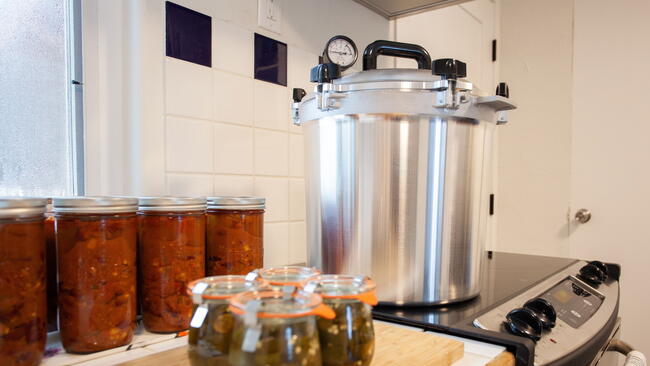As a casual cook, I usually throw together a dish quickly based on what’s in season, but in the area of food safety, I’m a stickler for the rules. One in six Americans this year will get sick from something they ate. Don’t be the one! Here are four food safety guidelines to keep food safe.
Food Safety is a Real Issue
One in six Americans this year will get sick from something they ate. According to the Center for Disease Control and Prevention (CDC): Of the 48 million people who get sick from something they’ve eaten, 128,000 of them end up in the hospital, and 3,000 die.
Sobering.
So, I’m the one on the summer festival planning committee who insists that the donated watermelons be scrubbed with a stiff brush and rinsed off with a hose before cutting and serving them.
I’m the one at the summer potluck who insists that the deviled eggs and the chicken salad stay in their coolers before and after their brief appearance on the serving table, and that the grilled chicken and burgers get tested for doneness with a meat thermometer and eaten soon after cooking, or refrigerated for reheating later.
Food contamination can happen at any point along the chain from soil to plate.
Almost every day the news offers up some story of a food recalled for (usually) bacterial contamination, or of restaurant patrons, cruise-ship travellers, or school children falling sick from something prepared in a presumably licensed commercial or institutional kitchen.
As many as 15 federal agencies play some role in overseeing food safety in the U.S., primarily the Food Safety and Inspection Services (FSIS) of the U.S. Department of Agriculture, the Food and Drug Administration (FDA), and the Centers for Disease Control and Prevention (CDC).
Critics have charged that overlapping responsibilities, conflicts of interest, inadequate funding for inspectors, and lack of accountability and transparency in food production and processing make it a challenge to ensure a safe food supply.
Perhaps, like me, you produce and preserve a lot of your food and buy most of the rest of it from local growers. But don’t assume that growing your own or knowing the farmer who produced your food guarantees its safety. Pay close attention to what you do control and keep an eye out for recalls.
Four Basic Food Safety Guidelines
Most of what you need to know can be summed up in four words: clean, separate, cook, and chill. Here are four basic rules, based on foodsafety.gov guidelines.
1. Clean Hands, Utensils, and Produce
- Clean your hands before, during, and after touching food: Use plain soap and water—and scrub the backs of your hands, between your fingers, and under your nails for at least 20 seconds. Need a timer? Hum the “Happy Birthday” song from beginning to end twice. Also, clean hands after using the toilet, touching a child or animal, after blowing your nose, coughing, or sneezing. See our article on proper hand washing.
- Clean cutting boards, dishes, utensils, and countertops with hot, soapy water. Wash dishcloths often in the hot cycle of your washing machine.
- Clean produce. Rinse all fruits and vegetables under running water without soap, bleach, or commercial produce washes. Scrub firm produce like melons or cucumbers with a clean produce brush. Don’t wash meat, poultry, eggs, or bagged produce marked “pre-washed”.
2. Separate Foods. Don’t Cross-Contaminate
- Use separate cutting boards for fresh produce or other foods that won’t be cooked before they’re eaten versus raw meat, poultry, or seafood. Use separate plates and utensils for cooked and raw foods.
- Keep certain types of food separate. In your shopping cart, separate raw meat, poultry, seafood, and eggs from other foods and place packages of raw meat, poultry, and seafood in plastic bags if available. When you check out, place raw meat, poultry, and seafood in separate bags from other foods.
- At home, place raw meat, poultry, and seafood in containers or sealed plastic bags. Freeze them if you’re not planning to use them within a few days.
- In the fridge, keep eggs in their original carton and store them in the main compartment—not in the door.
3. Cook to the Right Temperature
Food is safely cooked when the internal temperature is high enough to kill germs that can make you sick.
- Use a food thermometer to be sure your food is safe. When you think your food is done, place the food thermometer in the thickest part of the food, making sure not to touch bone, fat, or gristle.
- Refer to our Minimum Cooking Temperatures Chart to be sure your foods have reached a safe temperature.
- Keep food hot (140˚F or above) after cooking: If you’re not serving food right after cooking, keep it out of the temperature danger zone by using a heat source like a chafing dish, warming tray, or slow cooker.
- Microwave food thoroughly (165˚F or above): Read package directions for cooking and follow them exactly to make sure food is thoroughly cooked. If the food label says, “Let stand for x minutes after cooking,” follow the directions—letting microwaved food sit for a few minutes enables colder areas to absorb heat from hotter areas.
4. Chill: Refrigerate and Freeze Food Properly
- Refrigerate perishable foods within 2 hours. If the food is exposed to temperatures above 90°F (like a hot car or summer picnic), refrigerate it within 1 hour. Check out this helpful chart from Keep Food Safe.
- Your refrigerator should be set to 40°F or below and your freezer to 0°F or below. Use an appliance thermometer to be sure.
- Never thaw or marinate foods on the counter. The safest way to thaw or marinate meat, poultry, and seafood is in the refrigerator.
- Know when to throw out food by checking our Safe Storage Times chart. Be sure you throw food out before harmful bacteria grow.
Home food preservation
A national survey conducted in 2000 revealed a high percentage of home food processors are using practices that put them at high risk for foodborne illness and economic losses due to food spoilage.
I’ve blogged on the topic of home food preservation before: Preserving Summer Abundance? Keep it safe!
The bottom line? Always follow USDA’s kitchen-tested recipes for home food preserving, available online at the National Center for Home Food Preservation, based at the University of Georgia.
And the final words of wisdom regarding food safety: When in doubt, throw it out!
Learn More:
Food safety myths: Most folks believe one or more of these myths. Go ahead, test yourself!
You can’t tell by looking at the food if it’s safe You really can’t. You need to cook meats, fish, and poultry to the temperature needed to kill germs. Measure with a meat thermometer. After cooking, eat the hot foods and refrigerate leftovers.
Ask Karen Ask a question online, receive an answer from a large knowledge base of common food safety questions .
Investigating Foodborne Outbreaks Learn about the complex process of tracking down the source of a food-poisoning outbreak.










Comments